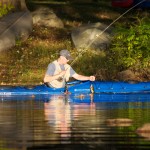In conversation and comments from around the lake, the weeds and algae are common topics — especially in the summer. One thing to remember is: We live on a lake, not next to a pool. The lake supports a multitude of animal and plant life. It is all interconnected and interdependent. And we have a large impact on it.
Many of the actions we take directly impact the health of the lake. For example, lawns leading right up to the lake shore encourage geese to land here and nest. Geese that are born and fledged here will return. Geese prefer an unimpeded path from their favorite food: Kentucky Ryegrass (aka lawn) and their water escape route. If you need a perfectly manicured lawn, consider planting a shoreline buffer of wildflowers and tall grasses. This will discourage geese from making your lawn their recreation area. And it will encourage beneficial insects and help native species.
Another area we affect the lake ecosystem is when we treat the lake to cut down on the plant and algae growth. As an extreme example: If we treated the lake to eliminate all plant life, it would kill all of the animals that rely on the plants for food. Then as the water heats up, we would suffer through blooms of toxic blue-green algae. That is definitely on our list of “no thanks.”
In our treatment plan, now managed by The Pond and Lake Connection, we are mainly looking to control the shoreline plants and algae growth that interfere most with the recreational value of the lake. This means we leave the middle of the lake alone since having plants in the water helps the fish, keeps the dissolved oxygen levels high, and can help prevent single celled blue-green algae — which thrive in low-oxygen conditions — from taking over the lake water in the dog days of August.
Our herbicide treatments are usually in the late spring just before Memorial Day weekend in May and once or twice in the early summer as needed. Algae treatments start in late July and can go into August. We are not allowed to treat the lake if dissolved oxygen levels fall to very low levels. This sometimes happens in the late summer and if it occurs, we have to wait for the water to cool down to treat the lake.
We strive for balance, but sometimes nature has other ideas. Plants and algae grow in the lake because that’s what plants do. They have 14 hours of sunlight each day during the summer to fuel them. For the shoreline variety, have to think about them like your lawn. If you don’t mow your lawn it will overgrow and you will not be able to walk through it. The same is true for your “water lawn†– no maintenance and the area around and beyond your dock grows wild. Some people like it that way, others want a clear waterfront. Others simply want a path to swim or boat out from their shoreline. Your needs dictate the extent of the action you personally take.
We have found if you want to control the plant growth around your waterfront or dock, the best and most effective way to control it is hand harvesting or cutting – then removing the plants from the water to dry and then compost. This can be time consuming and labor intensive, but the results typically last 4-6 weeks (sometimes as little as 1 week during peak season). The more you maintain, the easier it becomes over time.
(Note: If you would like more information about tools designed to make harvesting weeds and algae easier, check this page.)
Some other helpful articles from past years:

